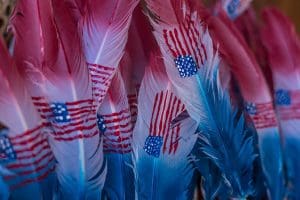American Indians and Alaska Natives serve in the Armed Forces at five times the national average and have served with distinction in every major conflict for over 200 years. Considering the population of the U.S. is approximately 1.4 percent Native and the military is 1.7 percent Native (not including those that did not disclose their identity), Native people have the highest per-capita involvement of any population to serve in the U.S. military.
They also have a higher concentration of women servicemembers than all other groups. Nearly 20 percent of American Indians and Alaska Natives servicemembers were women, while 15.6 percent of all other servicemembers were women.
During World War I, 3,000 to 6,000 American Indians enlisted and another 6,500 were drafted. About two-thirds served in the infantry, winning widespread praise for bravery and achievement. But the cost was high: About five percent of American Indian combat soldiers were killed, compared to one percent of American forces overall.
Back in the states, some 10,000 American Indian women joined the Red Cross, donating time, money and clothing. American Indian people also bought war bonds. By the war’s end in November 1918, they owned $25 million in bonds (about 75 dollars for every American Indian man, woman and child).
During World War I and World War II, a variety of American Indian languages were used to send secret military messages — codes that enemies were never able to break. In World War I, Choctaw and other American Indians transmitted coded messages by telephone in their tribal languages. Although not used extensively, the telephone squads were key in helping the U.S. win several battles that ended the war.
 American Indians enlisted in overwhelming numbers after the attack on Pearl Harbor in 1941. Just like in World War II, the army used American Indian recruiters to find Native-language speakers who were willing to enlist. The Marine Corps recruited Navajo code talkers in 1942 and even established a code-talking school. Forty-four thousand of a total American Indian population of 350,000 saw active duty, including nearly 800 women. For this service they earned at least 71 Air Medals, 34 Distinguished Flying Crosses, 51 Silver Stars, 47 Bronze Stars and five Medals of Honor.
American Indians enlisted in overwhelming numbers after the attack on Pearl Harbor in 1941. Just like in World War II, the army used American Indian recruiters to find Native-language speakers who were willing to enlist. The Marine Corps recruited Navajo code talkers in 1942 and even established a code-talking school. Forty-four thousand of a total American Indian population of 350,000 saw active duty, including nearly 800 women. For this service they earned at least 71 Air Medals, 34 Distinguished Flying Crosses, 51 Silver Stars, 47 Bronze Stars and five Medals of Honor.
Approximately 10,000 American Indian soldiers fought during the Korean War, and around 194 died in battle. During the Vietnam War, of the 42,000 American Indians who served, 90 percent were volunteers. Approximately one of every four eligible American Indian people served, compared with one of 12 in the general population. Of those, 226 died in action and five received the Medal of Honor.
Since the Gulf War, the U.S. has been engaged in an ongoing series of conflicts, primarily in Afghanistan and Iraq. American Indian men and women continue to serve in high numbers at home and abroad. According to the Department of Defense, more than 24,000 of the 1.2-million current active-duty servicemembers are American Indians, and the 2010 Census identified over 150,000 American Indian and Alaska Native veterans.
Sadly, American Indian and Alaska Native veterans have lower incomes, lower educational attainment and higher unemployment than veterans of other races. They are also more likely to lack health insurance and have a disability, service-connected or otherwise, than veterans of other races. About 19 percent of American Indian and Alaska Native veterans had a service-connected disability rating in 2010, compared with 16 percent of veterans of all other races, according to the Department of Defense.
To date, 27 American Indians have been awarded the Medal of Honor, the nation’s highest military honor. American Indians have participated in every major U.S. military encounter from the Revolutionary War to today’s conflicts in the Middle East, yet no landmark in our nation’s capital recognizes this contribution. Thankfully, the Smithsonian’s National Museum of the American Indian is currently working on a National Native American Veterans Memorial, anticipated for Veterans Day 2020.
Please add me to info mailing list especially about the new memorial in D.C. and updates due to Covid
Please add me also to info mailing list including information about the new memorial in D.C. and updates.
Thanks very much
Betty L. McLane-Iles
Please keep me updated on the Memorial. I served with Native Americans in the USMC
Thank you all for your service.. Each one of you…Blessings to you all!
I seen on other sources so I looked at this your page: “Native people have the highest per-capita involvement of any population to serve in the U.S. military.” Very honorable. ! Thankful for every one of them. Just wanted to ask if you know which native American tribes have the highest enlistment? Like a list.
Thank you for your service.
thank you so.much for your swrvice to usa military…God bless you all who gave yojr lives to ww1 ww2…
To the Natives American Indians and Alaska native both male and female; Thank you for your service,unselfish and forgiveness to the bad you undoubtedly face and never complained….we see you…we see you and again…Thank you all for your Service
Thank you for your service and sacrifices! You all deserve so much more than a monument but what a great reminder and a way to honor you.